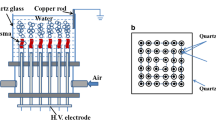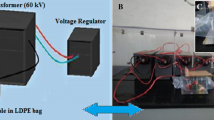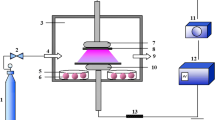Abstract
Recently, non-thermal plasma-activated water (PAW) became a relatively new concept developed in the food industry. The effects of PAW on fruit decay, microbial loads, and quality of postharvest Chinese bayberry were investigated. Chinese bayberries were treated by PAW for 0.5, 2, or 5 min and then stored at 3 °C for 8 days. Experimental results show that all PAW treatments could reduce fruit decay by around 50 % compared to control at the end of storage. There was no dose-effect relationship between PAW treatment time and fruit decay. Meanwhile, a 0.5-min PAW treatment could remarkably decrease microbial population on Chinese bayberries during storage, and the maximum reductions reached around 1.1 log CFU/g both for bacteria and fungi at the end day of storage. Scanning electron microscopy results reveal that PAW could significantly change the morphology of microbial cells on Chinese bayberries. Moreover, physicochemical properties analysis of PAW demonstrates that the microbial inactivation of PAW is mainly attributed to the combined action of high oxidation reduction potential and low pH. Additionally, PAW-treated fruits exhibited markedly higher firmness, color index of red grapes, and total soluble solids than the control did at the eighth day. These results indicate that PAW might be a promising strategy to control fruit decay and maintain quality of Chinese bayberry during postharvest storage.








Similar content being viewed by others
References
Abdel-Aal, E. M., & Hucl, P. (2003). Composition and stability of anthocyanins in blue-grained wheat. Journal of Agricultural and Food Chemistry, 51, 2174–2180.
Ames, B. M., Shigena, M. K., & Hagen, T. M. (1993). Oxidants, antioxidants and the degenerative diseases of aging. Proceedings of the National Academy of Sciences of the United States of America, 90, 7915–7922.
Bao, J. S., Cai, Y., Sun, M., Wang, G. Y., & Corke, H. (2005). Anthocyanins, flavonols and free radical scavenging activity of Chinese bayberry (Myrica rubra) extracts and their color properties and stability. Journal of Agricultural and Food Chemistry, 53, 2327–2332.
Burlica, R., Grim, R. G., Shih, K. Y., Balkwill, D., & Locke, B. R. (2010). Bacteria inactivation using low power pulsed gliding arc discharges with water spray. Plasma Processes and Polymers, 7, 640–649.
Cantu, D., Vicente, A. R., Greve, L. C., Dewey, F. M., Bennett, A. B., Labavitch, J. M., & Powell, A. L. T. (2008). The intersection between cell wall disassembly, ripening, and fruit susceptibility to Botrytis cinerea. Proceedings of the National Academy of Sciences of the United States of America, 105, 859–864.
Cantu, D., Blanco-Ulate, B., Yang, L., Labavitch, J. M., Bennett, A. B., & Powell, A. T. (2009). Ripening-regulated susceptibility of tomato fruit to Botrytis cinerea requires NOR but not RIN or ethylene. Plant Physiology, 150, 1434–1449.
Chen, H. J., Yang, H. L., Gao, H. Y., Long, J., Tao, F., Fang, X. J., & Jiang, Y. M. (2013). Effect of hypobaric storage on quality, antioxidant enzyme and antioxidant capability of the Chinese bayberry fruits. Chemistry Central Journal, 7, 1–7.
Gao, L., & Mazza, G. (1994). Quantitation and distribution of simple and acylated anthocyanins and other phenolics in blueberries. Journal of Food Science, 59, 1057–1059.
Graves, D. B. (2012). The emerging role of reactive oxygen and nitrogen species in redox biology and some implications for plasma applications to medicine and biology. Journal of Physics D: Applied Physics, 45, 263001–263042.
Jin, P., Wu, X., Xu, F., Wang, X. L., Wang, J., & Zheng, Y. H. (2012). Enhancing antioxidant capacity and reducing decay of Chinese bayberries by essential oils. Journal of Agricultural and Food Chemistry, 60, 3769–3775.
Kamgang-Youbi, G., Herry, J. M., Meylheuc, T., Brisset, J. L., Bellon-Fontaine, M. N., Doubla, A., & Naïtali, M. (2009). Microbial inactivation using plasma-activated water obtained by gliding electric discharges. Letters in Applied Microbiology, 48, 13–18.
Heinonen, I. M., Meyer, A. S., & Frankel, E. N. (1998). Antioxidant activity of berry phenolics on human low-density lipoprotein and liposome oxidation. Journal of Agricultural and Food Chemistry, 46, 4107–4112.
Laroussi, M. (2005). Low temperature plasma-based sterilization: overview and state-of-the-art. Plasma Processes and Polymers, 2, 391–400.
Liao, C. H., Cooke, P. H., & Niemira, B. A. (2010). Localization, growth, and inactivation of Salmonella Saintpaul on Jalape˜no peppers. Journal of Food Science, 75, M377–M382.
Ma, R. N., Feng, H. Q., Li, F. T., Liang, Y. D., Zhang, Q., Zhu, W. D., Zhang, J., Becker, K. H., & Fang, J. (2012). An evaluation of anti-oxidative protection for cells against atmospheric pressure cold plasma treatment. Applied Physics Letters, 100, 123701–123704.
Ma, R. N., Feng, H. Q., Liang, Y. D., Zhang, Q., Tian, Y., Su, B., Zhang, J., & Fang, J. (2013). Atmospheric pressure cold plasma leads to apoptosis in Saccharomyces cerevisiae by accumulating intracellular reactive oxygen species and calcium. Journal of Physics D: Applied Physics, 46, 285401–285408.
Ma, R. N., Wang, G. M., Tian, Y., Wang, K. L., Zhang, J., & Fang, J. (2015). Non-thermal plasma-activated water inactivation of food-borne pathogen on fresh produce. Journal of Hazardous Materials, 300, 643–651.
Maeda, Y., Igura, N., Shimoda, M., & Hayakawa, I. (2003). Bactericidal effect of atmospheric gas plasma on Escherichia coli K12. International Journal of Food Science and Technology, 38, 889–892.
Moreau, M., Orange, N., & Feuilloley, M. G. J. (2008). Non-thermal plasma technologies: new tools for bio-decontamination. Biotechnology Advances, 26, 610–617.
Niemira, B. A. (2012). Cold plasma decontamination of foods. Annual Review of Food Science and Technology, 3, 125–142.
Oehmigen, K., Hähnel, M., Brandenburg, R., Wilke, C., & Weltmann, K. D. (2010). The role of acidification for antimicrobial activity of atmospheric pressure plasma in liquids. Plasma Processes and Polymers, 7, 250–257.
Pankaja, S. K., Bueno-Ferrera, C., Misraa, N. N., Milosavljevi, V., O’Donnellb, C. P., Bourkea, P., Keenera, K. M., & Cullen, P. J. (2014). Applications of cold plasma technology in food packaging. Trends in Food Science and Technology, 35, 5–17.
Selcuk, M., Oksuz, L., & Basaran, P. (2008). Decontamination of grains and legumes infected with Aspergillus spp. and Penicillium spp. by cold plasma treatment. Bioresource Technology, 99, 5104–5109.
Tian, Y., Ma, R. N., Zhang, Q., Feng, H. Q., Liang, Y. D., Zhang, J., & Fang, J. (2015). Assessment of the physicochemical properties and biological effects of water activated by non-thermal plasma above and beneath the water surface. Plasma Processes and Polymers, 12, 439–449.
Wan, J., Coventry, J., Swiergon, P., Sanguansri, P., & Versteeg, C. (2009). Advances in innovative processing technologies for microbial inactivation and enhancement of food safety–pulsed electric field and low-temperature plasma. Trends in Food Science and Technology, 20, 414–424.
Wang, K. T., Jin, P., Cao, S. F., Shang, H. T., Yang, Z. F., & Zheng, Y. H. (2009). Methyl jasmonate reduces decay and enhances antioxidant capacity in Chinese bayberries. Journal of Agricultural and Food Chemistry, 57, 5809–5815.
Wang, K. T., Cao, S. F., Jin, P., Rui, H. J., & Zheng, Y. H. (2010a). Effect of hot air treatment on postharvest mold decay in Chinese bayberry fruit and the possible mechanisms. International Journal of Food Microbiology, 141, 11–16.
Wang, K. T., Jin, P., Shang, H. T., & Zheng, Y. H. (2010b). Effect of methyl jasmonate in combination with ethanol treatment on postharvest decay and antioxidant capacity in Chinese bayberries. Journal of Agricultural and Food Chemistry, 58, 9597–9604.
Wang, K. T., Jin, P., Tang, S. S., Shang, H. T., Rui, H. J., Di, H. T., Cai, Y., & Zheng, Y. H. (2011). Improved control of postharvest decay in Chinese bayberries by a combination treatment of ethanol vapor with hot air. Food Control, 22, 82–87.
Xu, Y. Y., Tian, Y., Ma, R. N., Liu, Q. H., & Zhang, J. (2016). Effect of plasma activated water on the postharvest quality of button mushrooms. Agaricus bisporus. Food Chem., 197, 436–444.
Yang, Z. F., Zheng, Y. H., & Cao, S. F. (2009). Effect of high oxygen atmosphere storage on quality, antioxidant enzymes, and DPPH-radical scavenging actvity of Chinese bayberry fruit. Journal of Agricultural and Food Chemistry, 57, 176–181.
Yu, S., Chen, Q., Liu, J., Wang, K., Sun, S., Jiang, Z., Zhang, J., & Fang, J. (2015). Dielectric barrier structure with hollow electrodes and its recoil effect. Applied Physics Letters, 106, 244101–244104.
Zhang, W. S., Chen, K. S., Zhang, B., Sun, C. D., Cai, C., Zhou, C. H., Xua, W. P., Zhang, W. Q., & Fergusonc, I. B. (2005). Postharvest responses of Chinese bayberry fruit. Postharvest Biology and Technology, 37, 241–251.
Zhang, W. S., Li, X., Wang, X. X., Wang, G. Y., Zheng, J. T., Abeysinghe, D. C., Ferguson, I. B., & Chen, K. S. (2007). Ethanol vapour treatment alleviates postharvest decay and maintains fruit quality in Chinese bayberry. Postharvest Biology and Technology, 46, 195–198.
Zhang, Q., Liang, Y. D., Feng, H. Q., Ma, R. N., Tian, Y., Zhang, J., & Fang, J. (2013). A study of oxidative stress induced by non-thermal plasma-activated water for bacterial damage. Applied Physics Letters, 102, 203701–203704.
Zhang, Q., Ma, R. N., Tian, Y., Su, B., Wang, K. L., Yu, S., Zhang, J., & Fang, J. (2016). Sterilization efficiency of a novel electrochemical disinfectant against Staphylococcus aureus. Environmental Science & Technology, 50, 3184–3192.
Zheng, Y. H., Yang, Z. F., & Chen, X. H. (2008). Effect of high oxygen atmospheres on fruit decay and quality in Chinese bayberries, strawberries and blueberries. Food Control, 19, 470–474.
Acknowledgments
This work was supported by the Peking University Biomed-X Foundation.
Author information
Authors and Affiliations
Corresponding author
Rights and permissions
About this article
Cite this article
Ma, R., Yu, S., Tian, Y. et al. Effect of Non-Thermal Plasma-Activated Water on Fruit Decay and Quality in Postharvest Chinese Bayberries. Food Bioprocess Technol 9, 1825–1834 (2016). https://doi.org/10.1007/s11947-016-1761-7
Received:
Accepted:
Published:
Issue Date:
DOI: https://doi.org/10.1007/s11947-016-1761-7




